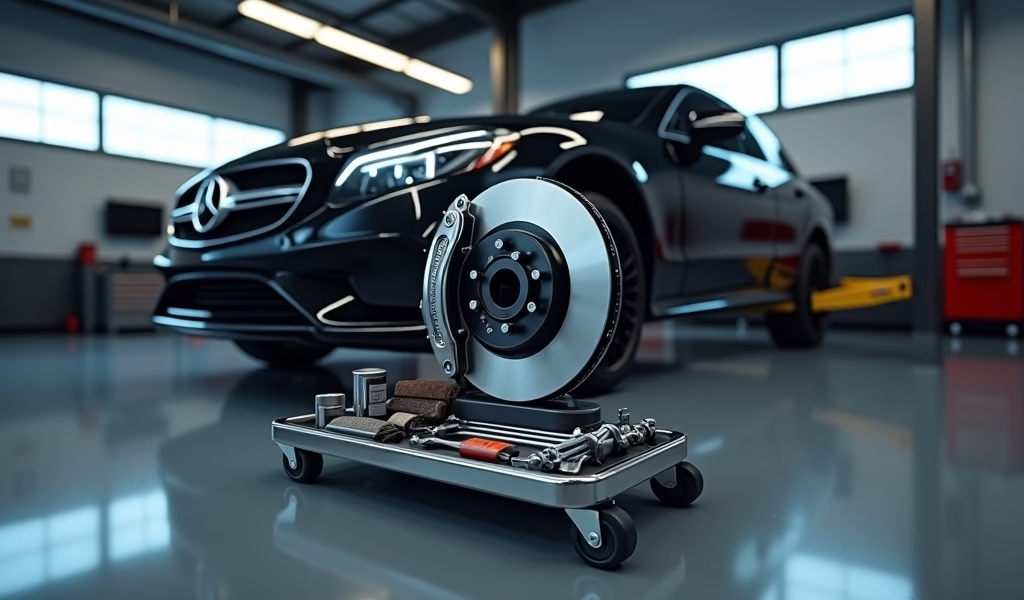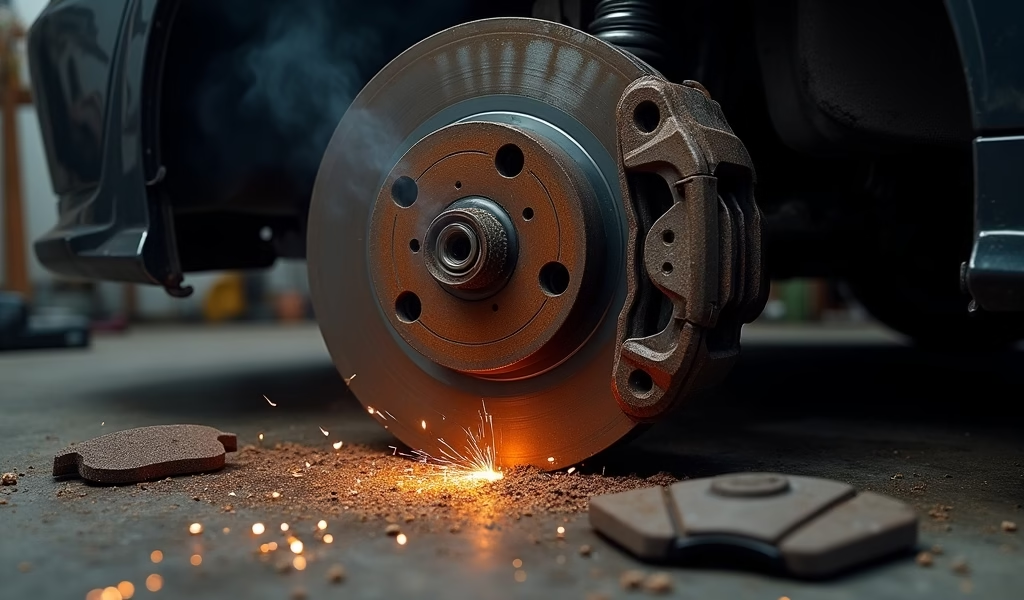Overview
This article presents five essential brake maintenance strategies that maximize safety and longevity: regularly checking brake fluid, inspecting brake pads, properly bedding new components, cleaning and lubricating mechanical parts, and adopting brake-friendly driving habits. These professional-grade techniques require minimal technical knowledge while providing significant safety benefits and cost savings by preventing premature wear and expensive repairs.
Table of Contents
- Introduction: Your Brakes Matter
- Hack #1: Master Regular Brake Fluid Maintenance
- Hack #2: The Art of Brake Pad Inspection
- Hack #3: Perfect the Brake Bedding Process
- Hack #4: Clean and Lubricate for Longevity
- Hack #5: Develop Brake-Friendly Driving Habits
- Conclusion: Bringing It All Together
- Frequently Asked Questions
Introduction: Your Brakes Matter
Car brakes are the silent guardians of your driving safety, working tirelessly every time you press that pedal. What would happen if your brakes failed when you needed them most? As a master mechanic with over 20 years in the field, I’ve seen firsthand how proper brake maintenance saves lives – and wallets.
Your car is the heartbeat of your daily routine, and its braking system is as important as the foundation of a house. Without reliable brakes, everything else about your vehicle becomes irrelevant. Safety isn’t just a feature – it’s the purpose.
Dedicated to delivering durability through smart service solutions, I’ll share five game-changing car brake maintenance hacks that professional mechanics typically charge a premium to provide. These techniques aren’t just theory – they’re battle-tested methods I’ve refined through thousands of brake jobs.
Let’s dive into these practical maintenance strategies that will keep your vehicle stopping safely for years to come – no mechanical experience required.
Hack #1: Master Regular Brake Fluid Maintenance
Brake fluid might seem insignificant, but it’s the lifeblood of your entire braking system. This specialized hydraulic fluid transfers the force from your foot to the components that actually slow your wheels. Over time, brake fluid naturally absorbs moisture from the atmosphere – even through microscopic pores in your brake lines.
This moisture contamination is your braking system’s silent enemy. When water enters your brake fluid, it lowers the fluid’s boiling point dramatically. During hard braking, contaminated fluid can actually boil, creating gas bubbles that compress when you press the pedal – resulting in that terrifying “spongy” feeling when you need to stop quickly.
Here’s how to check your brake fluid like a pro:
- Locate the brake fluid reservoir (usually a small, semi-transparent container near the back of the engine bay, on the driver’s side)
- Check that fluid levels fall between the “MIN” and “MAX” lines (check when the vehicle is level)
- Examine the color – new fluid ranges from clear to light amber; dark brown or black indicates contamination
- Pay attention to clarity – cloudy fluid suggests moisture contamination
Most manufacturers recommend changing brake fluid every 2-3 years regardless of mileage. However, many drivers go 5+ years without changes, putting themselves at risk. According to NHTSA safety data, brake system failures contribute to approximately 22% of vehicle mechanical-cause crashes.
If you notice any of these warning signs, don’t wait for your scheduled maintenance:
- Soft or spongy brake pedal feel
- Increased stopping distance
- ABS warning light illumination
- Fluid that appears dark or contains visible particles
Fresh brake fluid is relatively inexpensive, typically costing $50-100 for a professional flush, or about $25 for DIY materials. Considering a complete brake repair due to damage from contaminated fluid can exceed $1,000, regular fluid maintenance isn’t just smart – it’s economical.
Hack #2: The Art of Brake Pad Inspection

Brake pads are the workhorses of your braking system – they create the friction that actually stops your vehicle. Learning to inspect them regularly is perhaps the simplest yet most effective maintenance hack in your arsenal.
Many vehicles allow for visual brake pad inspection without removing the wheels. Simply look through the spaces in your wheel with a flashlight, focusing on the pad material pressed against the brake rotor. Most brake pads start with about 10-12mm of friction material and should be replaced when they reach 3-4mm thickness.
Can’t see your pads clearly? Listen for these warning signals instead:
- High-pitched squealing when braking (this is the wear indicator making contact)
- Grinding or growling noises (indicates metal-on-metal contact – immediate attention required)
- Vibration in the brake pedal (potentially warped rotors from overheated, thin pads)
- Vehicle pulling to one side when braking (uneven pad wear or caliper issues)
Replacing pads before they damage your rotors can save hundreds. While a typical brake replacement with just pads costs $150-300 per axle, adding rotor replacement typically doubles the price.
Should you DIY or hire a pro? Consider these factors:
- DIY pad replacement can save 40-60% on labor costs
- Professional installation ensures proper torque specifications and safety checks
- Vehicles with electronic parking brakes or complex brake systems often require professional tools
- Some premium vehicles need computer recalibration after brake service
I’ve seen countless DIY efforts go sideways – from cross-threaded caliper bolts to improperly seated pads. If you’re mechanically inclined, tackling brake pads can be rewarding, but never compromise safety to save money. When in doubt, consult the pros.
Hack #3: Perfect the Brake Bedding Process
Here’s a technique that separates professional mechanics from amateurs – proper brake bedding. This critical process creates an even transfer layer of brake pad material onto your rotors, optimizing stopping power and minimizing noise. Think of it as “introducing” your pads to your rotors in a controlled way before demanding peak performance.
Whether you’ve just installed new pads or rotors, proper bedding is essential. Skip this step, and you risk premature wear, uneven braking performance, and that annoying squeal that makes your passengers cringe.
Here’s my tried-and-true bedding procedure:
- Find a safe, low-traffic road with good visibility
- Accelerate to 35-40 mph
- Apply moderate brake pressure to slow to 5-10 mph (don’t come to a complete stop)
- Repeat 8-10 times, allowing 30 seconds between cycles for cooling
- Then perform 2-3 slightly more aggressive stops from 45-50 mph down to 10 mph
- Drive gently for 5-10 minutes without stopping to allow proper cooling
- Avoid hard stops for the next 200-300 miles
The most common mistake I see is performing emergency stops immediately after installation or skipping the bedding process entirely. Either approach can create uneven pad deposits and potentially warp rotors.
Done properly, brake bedding can extend pad life by up to 30% and significantly reduce noise. One SAE International study found that proper bedding can improve initial braking performance by up to 40% compared to non-bedded systems.
This simple 20-minute procedure costs nothing but can save you hundreds in premature replacement costs and unnecessary brake service. It’s the definition of preventative maintenance – a small investment of time for a significant performance return.
Hack #4: Clean and Lubricate for Longevity
Your braking system operates in one of the harshest environments on your vehicle. It endures extreme temperature cycles, road salt, water, and abrasive dust. Over time, these elements can cause components to stick, bind, and corrode – compromising safety and performance.
Regular cleaning and proper lubrication are the secret weapons professional mechanics use to extend brake life significantly. This maintenance hack focuses on the often-neglected mechanical components surrounding your brake pads.
Components that benefit from cleaning and lubrication include:
- Caliper guide pins and bushings (stuck pins cause uneven pad wear)
- Caliper piston boots (prevents corrosion and sticking)
- Pad backing plates and contact points (reduces noise and improves pad movement)
- Hardware clips and anti-rattle springs (prevents annoying brake squeaks)
For cleaning, use only a dedicated brake cleaner spray – never household cleaners or general degreasers. These specialized solvents remove contaminants without leaving residue that could affect braking performance.
When lubricating, use only high-temperature brake grease specifically designed for braking systems. Apply sparingly to metal-on-metal contact points only. Keep all lubricants away from friction surfaces (pad faces and rotors)!
This maintenance should be performed during any brake service or at least annually in regions with harsh winters or coastal areas where salt exposure is common. A properly lubricated braking system moves freely, wears evenly, and provides consistent stopping power in all conditions.
For vehicles over five years old, I recommend a complete caliper disassembly, cleaning and rebuild during pad replacement – especially if you notice uneven pad wear or pulling during braking. Professional brake service that includes this level of attention typically costs 20-30% more but can double the lifespan of your braking components.
Hack #5: Develop Brake-Friendly Driving Habits

The most powerful brake maintenance hack costs absolutely nothing to implement – changing how you drive. Your daily driving habits have a dramatic impact on brake component lifespan. I’ve seen identical vehicles with the same mileage have completely different brake wear patterns based solely on driving style.
Smart service solutions begin with smart driving techniques. Here are the brake-saving habits I practice and recommend:
- Look farther ahead while driving to anticipate stops (allowing gradual deceleration)
- Maintain greater following distance to avoid panic stops (the “three-second rule” minimum)
- Remove unnecessary weight from your vehicle (every 100 pounds increases braking distance)
- Use engine braking when appropriate by downshifting or choosing lower gears on descents
- Avoid “two-foot driving” – never rest your left foot on the brake pedal
Aggressive drivers typically replace brake components 2-3 times more frequently than smooth operators. Beyond the financial implications, aggressive braking increases stopping distances during emergencies (due to heat-soaked components) and creates more harmful brake dust that impacts air quality.
One of my customers, a delivery driver, extended her brake life from 25,000 miles to over 70,000 miles simply by implementing these driving techniques. The financial savings exceeded $800 over three years – not counting the convenience of fewer shop visits.
For electric and hybrid vehicle owners, regenerative braking systems offer additional opportunities to extend friction brake life. By maximizing the energy recovery settings in your vehicle, you can significantly reduce conventional brake usage. Many Tesla owners report brake pad life exceeding 100,000 miles through effective use of regenerative braking.
These habits create a virtuous cycle of benefits: extended component life, improved fuel efficiency, reduced environmental impact, and a smoother, more relaxed driving experience. As we like to say in the shop, “Smooth drivers make for smooth rides and slimmer repair bills.”
Conclusion: Bringing It All Together
Your car’s braking system isn’t just another maintenance item – it’s the most critical safety system in your vehicle. By implementing these five maintenance hacks – regular fluid checks, pad inspections, proper bedding procedures, component lubrication, and brake-friendly driving – you’re creating a comprehensive protection plan for both your safety and your wallet.
Think of these hacks as the foundation of a relationship between you and your vehicle. Like any good relationship, consistent attention and care lead to longevity and reliability when you need it most. The beauty of these techniques is their accessibility – most require minimal technical knowledge but deliver professional-grade results.
While DIY maintenance steps are invaluable, they don’t replace the need for professional inspections. I recommend having your braking system professionally evaluated at least annually or every 15,000 miles, whichever comes first. A trained eye can spot potential issues before they become dangerous failures.
Remember that brake maintenance isn’t just about saving money – though these hacks certainly will. It’s about ensuring that when you need to stop quickly, your vehicle responds instantly and predictably. After all, what would happen if your brakes failed when you needed them most? That’s a scenario no driver should ever experience.
Implement these maintenance techniques, drive mindfully, and enjoy the peace of mind that comes with a properly maintained braking system. Your car – and everyone who rides in it – will thank you.
Frequently Asked Questions
How often should I replace my brake pads?
Most brake pads last between 30,000-70,000 miles depending on driving habits and vehicle type. Replace them when they reach 3-4mm thickness or if you hear squealing/grinding noises.
What causes brake squeaking and how can I fix it?
Brake squeaking is typically caused by vibration between the pad and rotor, often due to glazed pads, lack of lubricant on contact points, or cheap pad materials. Apply brake-specific lubricant to pad backing plates and hardware (never on friction surfaces) or consider upgrading to premium pads.
Is it normal for my brake pedal to pulsate?
A pulsating brake pedal usually indicates warped rotors that need resurfacing or replacement. This warping typically occurs from overheating due to aggressive driving or dragging brakes.
How do I know if I need new brake fluid?
Your brake fluid needs changing if it appears dark brown/black instead of clear/amber, or every 2-3 years regardless of appearance. Soft pedal feel and decreased braking performance are other key indicators of contaminated fluid.
Can I just replace brake pads without replacing rotors?
You can often replace just the brake pads if your rotors are still within thickness specifications and don’t show signs of scoring or cracking. However, replacing or at minimum resurfacing rotors during pad replacement provides optimal braking performance and reduces noise.

